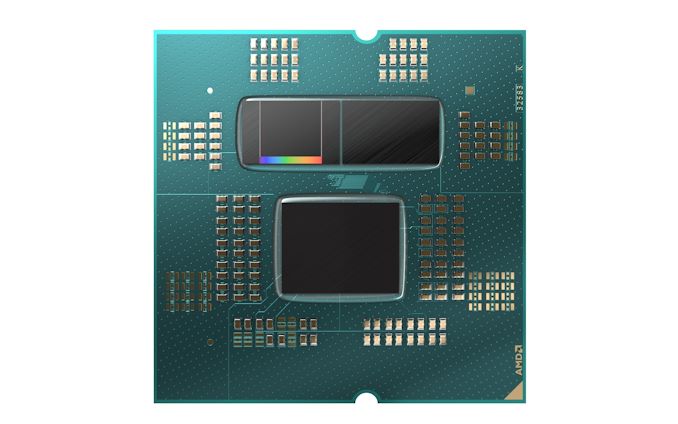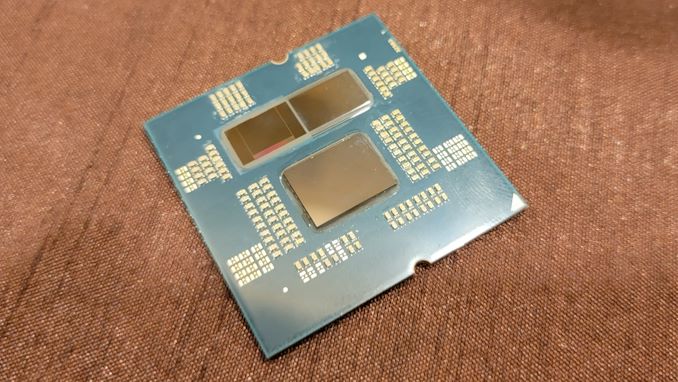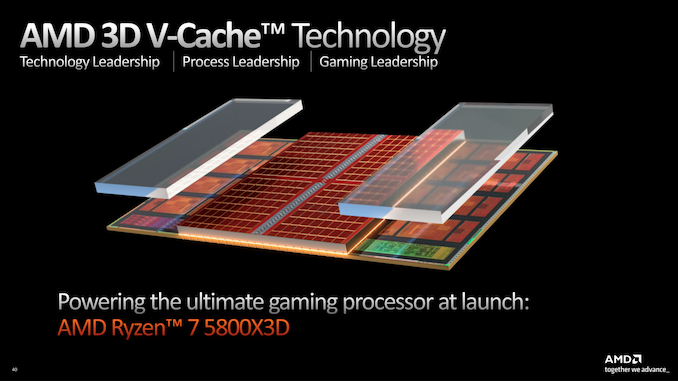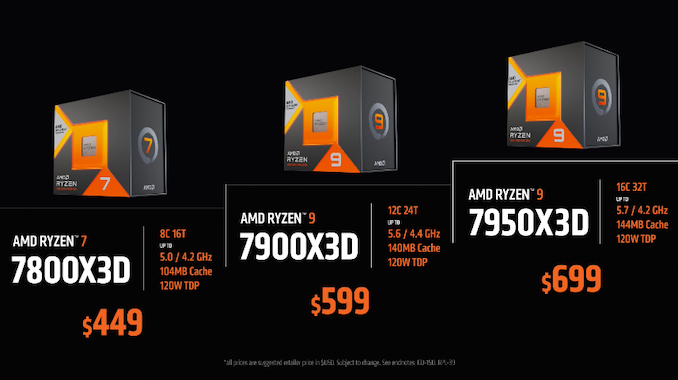AMD’s Ryzen 7000X3D Chips Get Release Dates: February 28th and April 6th, For $699/$599/$449
by Ryan Smith on February 1, 2023 9:45 PM EST- Posted in
- CPUs
- AMD
- X3D
- Ryzen 7000
- Raphael
- 3D V-Cache

AMD today has announced the launch date and prices for its eagerly anticipated Ryzen 7000X3D series processors. Aimed primarily at gamers, the company’s first L3 V-Cache equipped Ryzen 7000 processors will begin rolling out on February 28th, when the Ryzen 9 7950X3D and Ryzen 9 7900X3D go on sale for $699 and $599 respectively. This will be followed up by the Ryzen 7 7800X3D a bit over a month later, when it goes on sale for $449 on April 6th.
First announced to great fanfare during AMD’s CES 2023 keynote (and teased well before that), the Ryzen 7000X3D chips will be AMD’s second generation of consumer chips employing the company’s novel 3D stacked V-Cache technology. V-Cache allows AMD to stack a 64MB L3 cache die on top of their existing CCDs in order to expand the total L3 capacity of a Zen 3/4 CCD, going from 32MB to 96MB. And in the case of multi-CCD designs such as the Ryzen 9 7950X, bringing the total, chip-wide L3 cache pool to 128MB.
| AMD Ryzen 7000X/X3D Series Line-Up | |||||||
| AnandTech | Cores Threads |
Base Freq |
Turbo Freq |
L3 Cache |
TDP | Price (Street) |
Release Date |
| Ryzen 9 7950X3D | 16C / 32T | 4.2 GHz | 5.7 GHz | 128 MB | 120W | $699 | 02/28/23 |
| Ryzen 9 7950X | 16C / 32T | 4.5 GHz | 5.7 GHz | 64 MB | 170W | $583 | - |
| Ryzen 9 7900X3D | 12C / 24T | 4.4 GHz | 5.6 GHz | 128 MB | 120W | $599 | 02/28/23 |
| Ryzen 9 7900X | 12C / 24T | 4.7 GHz | 5.6 GHz | 64 MB | 170W | $444 | - |
| Ryzen 7 7800X3D | 8C / 16T | 4.2 GHz | 5.0 GHz | 96 MB | 120W | $449 | 04/06/23 |
| Ryzen 7 7700X | 8C / 16T | 4.5 GHz | 5.4 GHz | 32 MB | 105W | $299 | - |
| Ryzen 7 5800X3D | 8C / 16T | 3.4 GHz | 4.5 GHz | 96 MB | 105W | $323 | - |
Following the successful trial of the technology in the consumer space with AMD’s original Ryzen 7 5800X3D, which was released to positive acclaim back in the spring of 2022, AMD has developed a much broader lineup of V-Cache equipped Ryzen chips for this generation. This includes not only the 5800X3D’s direct successor, the 8 core Ryzen 7 7800X3D, but also, for the first time, chips employing multiple CCDs. These are the Ryzen 9 7900X3D and 7950X3D, which will offer 12 and 16 CPU cores, respectively.
Interestingly, AMD has gone for a non-homogenous design for these multi-CCD parts – rather than giving both CCDs V-Cache, AMD is only outfitting one of the CCDs with the extra L3 cache. The other CCD will remain a plain Zen 4 CCD, with its integrated 32MB of L3 cache. The unbalanced design, besides allowing AMD to control the costs of what’s still a relatively expensive technology to implement, will allow AMD to offer something close to the best of both worlds for their multi-CCD parts. The V-Cache equipped Zen 4 CCDs will offer 6 or 8 CPU cores backed by the massive L3 pool, for tasks that benefit from the larger cache size, while the vanilla Zen 4 CCDs will be unencumbered by the V-Cache, allowing them to clock higher for pure throughput workloads that wouldn’t benefit from the extra cache.
As with the original 5800X3D, AMD is aiming these chips at gamers in particular, as the complex, heavy-dataset nature of video games means they often benefit from having additional L3 cache on-hand. The 5800X3D was, depending on the game, around 15% faster than its vanilla Ryzen counterpart – at least so long as it wasn’t GPU limited. AMD is being a bit more coy this time around on making apples-to-apples comparisons against their regular Ryzen 7000 chips, so for now the only official performance figures available from AMD are pitting the chips against the 5800X3D. In lieu of that, a 15% improvement is a reasonable baseline given that the cache sizes haven’t changed in the last generation, but we’ll definitely want to take a closer look at the final chips to see if the additional L3 cache is as beneficial to Zen 4 as it was for Zen 3.
Back at their CES 2023 keynote, AMD announced the specifications for two-and-a-half of the chips, as well as an undetailed February launch date. With today’s announcement, AMD is finally filling in the rest of the details, as well as confirming that only part of the product stack is going to make that February launch date.

(Image Courtesy Tom's Hardware)
As previously noted, the Ryzen 9 7950X3D and Ryzen 9 7900X3D both launch on February 28th. The 16 core 7950X3D will hit the streets with a $699 price tag, while the 12 core 7900X3D will intro at $599. At current street prices, this represents roughly a $100 to $150 premium over the chips’ regular counterparts, with the 7950X selling for around $583, and the 7900X selling for around $444. Prices on AMD’s top AM5 chips have come down a decent bit since their 2022 launch, so the new X3D SKUs are coming in at similar launch prices as their non V-Cache counterparts. Put another way, whereas $699 would get you a 16 core 7950X in September, come February it will get you the same chip with an additional 64MB of L3 cache.
Other than benchmarks, at this point the only detail we don’t have on the 7950X3D and 7900X3D are the clockspeeds for the V-Cache equipped CCDs. AMD’s quoted turbo clockspeeds are for the vanilla CCD, so it’s unclear just how much clockspeeds have been lowered for the V-Cache CCD. But taking a hint from AMD’s sole single CCD X3D part, the 7800X3D, we see that part has a top clockspeed of just 5.0GHz. So we’d expect something similar for the V-Cache CCDs on the Ryzen 9 parts.
Speaking of the Ryzen 7 7800X3D, we finally have the full specifications on AMD’s most straightforward X3D part. Back in January AMD hadn’t locked down the base clockspeeds on this part, but as of today we finally have the answer: 4.2GHz. The chip will, in turn, be able to turbo as high as 5.0GHz as previously noted.
The cheapest of the Z3D parts, with a price tag of $449, the 7800X3D will also be the laggard of the group, with the chip not launching until April 6th. AMD has not explained the gap in launch dates, but it’s reasonable to assume that AMD is prioritizing the assembly and shipping of their more expensive Ryzen 9 SKUs. In any case, at current street prices the 7800X3D will carry a $150 premium over the $299 7700X, making it a full 50% more expensive, assuming these street prices hold through April. This happens to be the same price the 5800X3D launched at, so AMD is technically just holding the line here, but it does underscore how price cuts on the rest of the Ryzen 7000 lineup have made the standard chips very competitive on a price/performance basis.
In any case, we’ll have more on AMD’s first V-Cache equipped Zen 4 chips later this month. Besides taking an in-depth look at the performance improvements brought about by the larger L3 cache, the other major factor driving performance is going to be the Windows thread scheduler. As this is AMD’s first asymmetric Ryzen CPU, it will be up to Windows and AMD’s chipset driver to figure out which CCD to place threads on for the 7950X3D/7900X3D. So this month’s launch is going to require that AMD’s hardware and software offerings are in sync in order for the company to make a good first impression.












64 Comments
View All Comments
Bruzzone - Tuesday, February 7, 2023 - link
7900X (non 3D) price to high volume retail is $274 so clearance price will be a smidge above. AMD contribution to the kit bundle when finding 7900X at $439 is around $50. 7900X3D retail low price is $462 but they're buying them from AMD for $299. Retails pays $349 for the 16C 3D so they're likely to be a reason to upsell from 12C to 16C. BUT here is a question, if on 7900X3D the frequency ccd is a quad is that component higher clocked then a full octa? I don't think hexa is bondable. mbGreenReaper - Friday, February 10, 2023 - link
Same configuration we ended up with, too. Don't really need more for most things.lopri - Thursday, February 2, 2023 - link
It must not cost that much to make these compared to regular Zen 4 CPUs. They are staggering the releases to squeeze the most out of the market. I am not a fan of AMD's sales tactic as of late.lmcd - Friday, February 3, 2023 - link
or it takes additional time to append a feature?seriously, come on
lopri - Sunday, February 5, 2023 - link
Re-reading it, my comment was not clear. I was referring to the later release of 7800X3D, after that of 7900X3D and 7950X3D.On the other hand, I hear that AMD has lowered the price of regular Zen 4 CPUs even more. In that case I would retract the above criticism as well. I take no issue of AMD going for high-end market segment while catering to the other market segments.
nandnandnand - Sunday, February 5, 2023 - link
We can't know for sure but they probably want to sell 7950X3D and 7900X3D first because they are more expensive but have roughly the same gaming performance as the cheaper 7800X3D, and because they want the first reviews showing absolute dominance over Intel. In theory these will look better in review charts because the games that don't need the extra cache can use the other chiplet. They must be confident in the asymmetric cache and clock speed approach.Zen 4 X non-3D CPUs are heavily discounted from MSRPs and will stay that way. Non-X get most of the performance of X. 7950X3D dropped in at the same $700 MSRP as the 7950X. 7900X3D got +$50, leaving it weirdly close to the superior 7950X3D (85.7% the price for 75% of the cores). 7800X3D also got +$50. At $450, it's the same price the 5800X3D was at launch.
These are expensive CPUs, but will most likely top the gaming charts for the rest of 2023. 7800X3D will be in high demand, and the 7900X3D is fascinating because it's teasing the $100 upsell to 7950X3D. If AMD set the wrong MSRP for 7900X3D, they can just let the price fall $20-80.
Bruzzone - Tuesday, February 7, 2023 - link
I've read through the comments and curious not in gaming applications performance necessarily but the professional modeling and simulation performance of 3D where an entire model fits in L3.According to wccftech on April 12, 2022 AMD would supply 50K units of 5800X3D per quarter and on channel data 1% of Vermeer CPUs produced in q1+2 of 22 = 234,207 units. I originally back in April estimated 18 to 24 months' worth of 5800X 3D in the 365K unit range I recall.
In q4 2022 AMD produced 4 M R7K following 13 M in q3. I suspect the entire lot of q4 Raphael production is 3D and 4 M is approximately AMD dGPU quarterly finished goods production on financial on channel sustaining inventory holding. CPU volume in unison with dGPU volume is a planning tactic and at 4 M 3D AMD would hold CPU gaming for the moment.
For those interested in holding out until run end R7X3D inventory clearing, here are the targets to know you are close;
7950X3D at $699 low retail is $576 and high-volume procurement price $349
See how AMD encourages stepping up to the 16C.
Note 70% of R7K channel (production) available is 79x0_ suggesting why octa is pushed out.
7900X3D at $599 low retail is $463 and high volume to OEM/retail = $299
7800X3D at $499 low retail is $351 and high volume procurement = $249
Intel Raptor desktop margins are up to 100% goosing the channel to push them through. R7K channel margins have been 30% and being pulled through think about it. R7K3D margin potential means they will be pushed all 4 M of them.
If there were to be a hexa which I discount requiring octa ccd for hybrid bonding interconnect (pad) and I agree with others pointing out it would cannibalize the 8C on more core per cache essentially, its retail MSRP would be $368 down to $275 run end clearance.
Mike Bruzzone, Camp Marketing
deil - Wednesday, February 8, 2023 - link
Availability will feel like they were released on Feb 29'thnandnandnand - Wednesday, February 8, 2023 - link
I'll be surprised if the 7900X3D flies off the shelves. The MSRP is too close to the 7950X3D.Sliderpro - Thursday, February 9, 2023 - link
I find it a bit disappointing that we don't get a 6 core CPU which makes sense due to being 8-2 cores to help with yield.Personally I wish there was a 4 core with 64mb cache with maybe 5.3-5.5 GHz at roughly 250$ price point. It would slap 5600x in single core and be perfectly good for gaming. Very few games would be able to max 4 cores powerful as these.